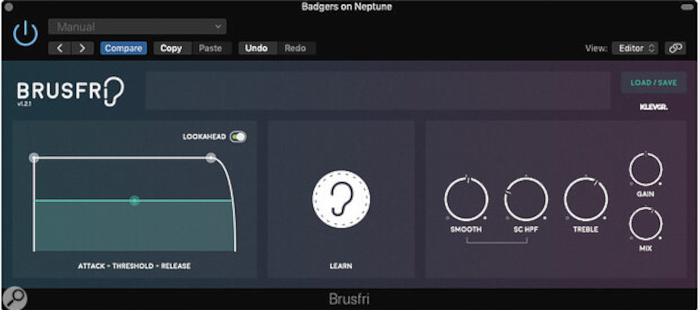Discover Brusfri, the cutting-edge audio noise reducer that combines advanced technology with an effortlessly simple interface. Designed to tackle noisy audio recordings, Brusfri excels at maintaining the original sound quality while effectively eliminating distractions. Unlike traditional noise reducers that often compromise audio integrity with phasing issues, Brusfri employs a series of finely-tuned gates to ensure a clean sound without unwanted artifacts. With features like frequency-specific expanders, Brusfri creates a smart noise suppression system that adapts to your audio needs. Experience an intuitive user interface that makes achieving professional results easier than ever.
Brusfri, Swedish for ‘Noise Free’, is a user-friendly noise-reduction plugin that supports all standard Mac/Windows plugin formats, including AAX (and has been optimized for Apple’s M1 processors), as well as AUv3 for iOS. It’s designed to attenuate steady-state noise by analyzing a short section of ‘noise-only’ recording. This information is used to set thresholds on multiple expanders/gates, each working on a narrow part of the frequency spectrum. This approach is very effective for dealing with hum, fan noise, electronic hiss, and similar issues but isn’t suitable for clicks and pops or noise that changes drastically over time.
You only need a second or two of noise-only recording for the process to work. The Learning function sets the thresholds for the expanders, but users can also make manual adjustments to the overall threshold level, and the attack and release times of the expanders if needed by dragging on the graph at the left of the GUI. An eye icon enables or disables lookahead, which adds a few milliseconds to the overall latency but provides advanced warning of transients. A Treble control is included to compensate for any high-end loss due to heavy denoising.
The Learning process involves holding the Learn button during the noise sampling period, after which the expanders are set up automatically. Additional controls are available for fine-tuning, especially in scenarios with significant noise, as processing can affect the higher-frequency harmonics of a sound, particularly at the ends of decaying notes. The Treble control can boost high frequencies to compensate, while Smooth adjusts the ratio of the internal expanders for smoother results at the cost of being less aggressive against heavy noise. HPF sets a low-cut filter in the detector sidechain to prevent very low-pitched noises (such as wind noise or stand vibrations) from influencing the processing. Mix adjusts the balance between the processed and unprocessed signal, and often, lowering the noise to an acceptable level produces more transparent results than aiming for complete removal.
I found Brusfri (v1.21 at the time of writing) easy to use and very effective against constant background noise like hiss, aircon fan noise, and steady ground-loop hum. While removing more noise can affect the high end of decaying sounds such as acoustic guitar or piano, Brusfri generally delivers good results when reducing noise by up to 12dB.
Conclusion
Brusfri may not feature the latest advancements in noise-reduction technology—such as those involving AI—but it is affordable, operates on a proven principle, and is easy to use, whether you’re tackling background hum on a guitar track or cleaning up a vocal recorded under less-than-ideal conditions. It also avoids the chirpy processing artifacts that some noise reducers produce, making it a valuable addition to the Klevgrand range. For many users, it could be the only noise reducer they ever need.
Information
$59.99


0 Comments